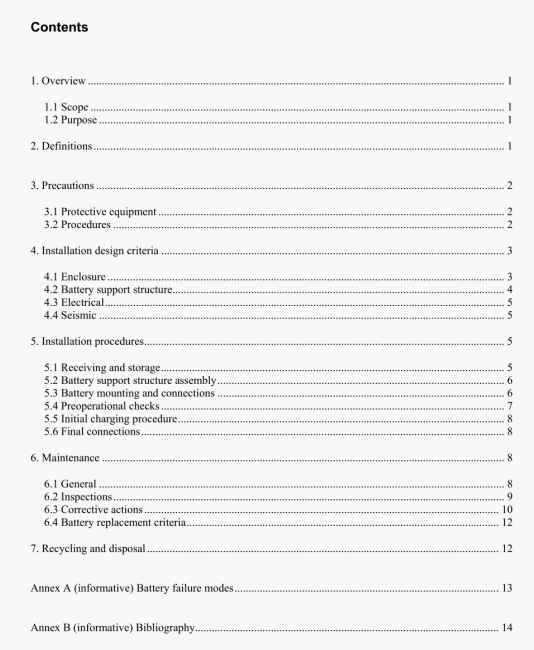IEEE Std 937:2007 pdf free download.IEEE Recommended Practice for Installation and Maintenance of Lead-Acid Batteries for Photovoltaic (PV) Systems.
c) The enclosure should be resistant to the effects of electrolyte, either by selection of materials used or by appropriatc coatings. Provision should be made for containmcnt of any spilled electrolyte per appropriate codes and regulations.
d) Any enclosure doors should allow unobstructed egress.
e) The enclosure design shouLd iriehtde appropriate means to prevent unauthorized entry.
4.1.3 Environmental considerations
The following ern.tronniental aspects should be considered dunng the design or selection of the battery enclosure:
a) The enclosure shall be ventilated, either by natural or induced means, to present the accumulation of an explosive hydrogen mixture and to limit the accumulation of other hazardous gases. Refer to IEEE Pl6351B101 for more int’onnation.
b) To present battery damage, the enclosure should be designed to assist in maintaining the electrolyte temperatLire abose its freezing point. Either passive or active means should be considered The temperature at which the electrolyte will freeze for a given battery state of charge S00 and operating specific gravity may be obtained from the battery manufacturer. Extremely high electrolyte temperatures will require temperature compensation of the charge voltage: otherwise, battery damage may result. Battery manufacturers may recommend a maximum operating temperature for their batteries, Refer to IEEE P1635 113101 for more information,
c) A cell electrolyte temperature of 25 °C is normally the basis for rated performance. A location where this temperature can be maintained should contribute to optimum battery life. Either passise or active means to reduce temperature excursions from 2$ °C should be considered. Passive means can include burial of enclosures, color of exterior tinish, and insulation. Active means can include forced-air ventilation. Elevated battery temperatures will lead to shortened life.
NOTE If the electrolyte temperature varies 1mm aØimUns. sizing may be alTectcd.
d) Temperature differences between cells within the battery should be limited to 3 rC. heat sources, including direct sunlight, radiators, steam pipes, and space heaters, should be avoided.
e) Illumination of enclosures during time of maintenance shouki be adequate for the safety and effectiveness of personnel.
4.2 Battery support structure
Battery support structures may consist of racks or other means fur supporting the battery within the enclosure. Battery support structures should have the following design features:
a) Provide suitable strength to support the battery.
b) Minimize temperature differentials (see item c of 4.1.3].
c) Provide space required for maintenance see item a of 4.1.21.
d) Be resistant to the effects of electrolyte.
e) Provide electrical isolation for the cell case and battery. Any insulating material used should be rated for full system voltage.
IEEE Std 937:2007 pdf free download
